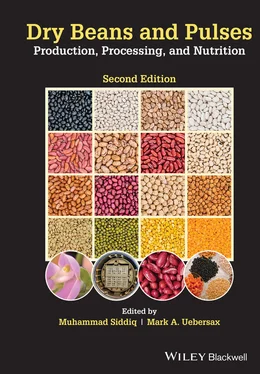Dry Beans and Pulses Production, Processing, and Nutrition
Здесь есть возможность читать онлайн «Dry Beans and Pulses Production, Processing, and Nutrition» — ознакомительный отрывок электронной книги совершенно бесплатно, а после прочтения отрывка купить полную версию. В некоторых случаях можно слушать аудио, скачать через торрент в формате fb2 и присутствует краткое содержание. Жанр: unrecognised, на английском языке. Описание произведения, (предисловие) а так же отзывы посетителей доступны на портале библиотеки ЛибКат.
- Название:Dry Beans and Pulses Production, Processing, and Nutrition
- Автор:
- Жанр:
- Год:неизвестен
- ISBN:нет данных
- Рейтинг книги:5 / 5. Голосов: 1
-
Избранное:Добавить в избранное
- Отзывы:
-
Ваша оценка:
- 100
- 1
- 2
- 3
- 4
- 5
Dry Beans and Pulses Production, Processing, and Nutrition: краткое содержание, описание и аннотация
Предлагаем к чтению аннотацию, описание, краткое содержание или предисловие (зависит от того, что написал сам автор книги «Dry Beans and Pulses Production, Processing, and Nutrition»). Если вы не нашли необходимую информацию о книге — напишите в комментариях, мы постараемся отыскать её.
The second edition of the most complete and authoritative reference on dry beans production, processing, and nutrition available Dry Beans and Pulses: Production, Processing, and Nutrition
Dry Beans and Pulses: Production, Processing, and Nutrition, Second Edition
Dry Beans and Pulses Production, Processing, and Nutrition — читать онлайн ознакомительный отрывок
Ниже представлен текст книги, разбитый по страницам. Система сохранения места последней прочитанной страницы, позволяет с удобством читать онлайн бесплатно книгу «Dry Beans and Pulses Production, Processing, and Nutrition», без необходимости каждый раз заново искать на чём Вы остановились. Поставьте закладку, и сможете в любой момент перейти на страницу, на которой закончили чтение.
Интервал:
Закладка:
Damaged beans: Damaged beans shall be beans and pieces of beans that are damaged by frost, weather, disease, weevils or other insects, or other causes.
Badly damaged beans: Badly damaged beans shall be beans and pieces of beans that are materially damaged or discolored by frost, weather, disease, weevils or other insects, or other causes so as to materially affect the appearance and quality of the beans.
Foreign material: Foreign material shall be stones, dirt, weed seeds, cereal grains, lentils, peas, and all matter other than beans.
Stones: Stones shall be concreted earthy or mineral matter, and other substances of similar hardness that do not disintegrate readily in water.
Contrasting classes: Contrasting classes shall be beans of other classes that are of a different color, size, or shape from the beans of the class designated.
Classes that blend: Classes that blend shall be sound beans of other classes that are similar in color, size, and shape to the beans of the class designated, and shall include white beans in the class yellow‐eye that are similar in size and shape to the yellow‐eye beans.
Broken beans: Broken beans shall be sound beans with some, but less than one‐fourth, of each bean broken off or with one‐fourth or more of the seed coat removed.
Blistered beans: Blistered beans shall be sound beans with badly blistered or burst seed coats.
Wrinkled beans: Wrinkled beans shall be sound beans that have deeply wrinkled seed coats and/or are badly warped or misshapen.
Weevily beans: Weevily beans shall be beans that are infested with live weevils or other insects injurious to stored beans or that contain weevil‐bored beans.
Clean‐cut weevil‐bored beans: Clean‐cut weevil‐bored beans shall be beans from which weevils have emerged, leaving a clean‐cut open cavity free from larvae, webbing, refuse, mold, or stain.
Well screened: Well screened, as applied to the general appearance of beans, shall mean that the beans are uniform in size, and are practically free from such small, shriveled, underdeveloped beans, splits, broken beans, larger beans, and foreign material that can be removed readily by the ordinary process of milling or screening through the proper use of sieves.
The USDA grading standards for chickpeas designate Kabuli and Desi types. Kabuli chickpeas average 8.5–10.5 mm in diameter and weigh 49 g per 100 seeds with external beige and with a golden yellow interior color. “US #1” Grade seed specified to contain not greater than 18% moisture, 2.0% defects, 2.0% total damaged, 0.5% foreign material, 0.2% stones, 0.5% contrasting classes, and 5% classes that blend. Thus, careful selection of purchase specifications are warranted to assure appropriate quality due to the broad standards established for “US #1.” “US#2” and “US #3” grades possess much higher tolerances that are outside the standards for product quality currently expected of canned chickpeas. For example, total defects range from 4–6%, contrasting classes 1–2%, and classes that blend 10–15% for US #2 and #3, respectively. These lower‐grade chickpeas are utilized for making hummus; however, the finished product may be slightly off‐color.
The USDA grade standards are established for lentils and are employed in commercial trade. The grade classes are designated as “US #1,” “US #2,” and “US #3.” Grading factors for these standards include the following:
Defective lentils, % (total = weevil‐damaged + heat damaged + damaged + splits); “US #1” ≤ 2.0%, “US #2” ≤ 3.5%, and “US #3” > 5.0%
Foreign material, % total and stones (“US #1” ≤ 0.2%, “US #2” < 0.5%, and “US #3” > 0.5)
Skinned lentils (≥ 3/4 seed coat missing)
Contrasting lentils – both size and color deviations from the predominant type (“US #1” ≤ 2.0%, “US #2” < 4.0%, and “US #3” > 4.0%). Lots with greater than 4.0% are subject to a limiting rule, which states that the lot may not be graded greater than “US #3”;
Minimum requirements for color use the following terminology: “US #1” = good, “US #2” = fair, “US #3” = poor.
Further, special grades for lentils may be designated by two size classes based on round hole sieve classification tolerances as follows: large lentils (3.0% <15/64 inch) and small lentils (95% > 15/64 inch, 80% > 12/64 inch, 3.0% < 9/64 inch). This size grade terminology is designated with the US grade (USDA 2017b).
SEED CERTIFICATION
The integrity of bean cultivars depends on bean seed propagation being secure and “true to type.” Without a secure seed supply, the identity of a commercial cultivar will likely “drift” and as such, the genetic and phenotypic traits will differ over time (generations). Strict quality control must be maintained to secure bean genetics in commercial seed production. This process is conducted under governmental (national/federal, state/provincial) and/or private sector certification programs.
The certification programs are governed by minimum standards set by members of the Association of Official Seed Certification Agencies (AOSCA), with the opportunity to adopt more stringent requirements on a state‐by‐state basis (Novak and Moore 2015). The policies and procedures for the Idaho Crop Improvement Association ( www.idahocrop.com) serve as a model for a secure seed quality program. Defined protocol and standards for growing, harvesting, and managing the seed by identify preserved lots are required for certification. Such programs commonly designate various levels of certification (e.g., foundation, registered, and certificated) based on the intensity of the production control tolerances applied. Foundation seed is usually produced by the originator of the variety and sold to seed producers to produce Registered seed. Registered seed is grown by seed producers to increase the supply for production of Certified seed. Certified seed is to be used for commercial production and in most cases cannot be used to produce another generation of certified seeds (Novak and Moore 2015).
The key elements of certified seed production include: grower application requirements, land requirements (e.g., freedom of bacterial blight), crop management (e.g., weed control and specific requirements for disease tolerance), and seed standards (e.g., pure seed, contrasting classes, weed seed, inert matter, splits and cracks, and germination percentage). Finally, strict control of harvesting and seed handling are used to assure integrity of the seed lots. Bean seed certification has had a regional and global impact on the integrity of cultivars and overall improvement of bean productivity (Idaho Bean Certification 2018).
SUMMARY
Market classes of dry beans are diverse in appearance and well defined for commercial trade. Each commercial class is handled as a discrete and independent bean type possessing differentiated characteristics and variable economical value. The extensive agronomic cultivation and the traditional use of beans among different cultures and their importance to global food supplies are well recognized and frequently provide the origins for enhanced value‐added products. Additionally, beans are commonly associated with high nutritional value and characteristic culinary appeal and comprise a broad array of distinctive sizes, shapes, and colors. These variations among bean classes provide distinctive culinary choices and a range of processed products that deliver simple and attractive meal options. The greatest economic value of beans is associated with the use of high‐quality intact whole seeds. The physiological structure and anatomical features of the bean seed (seed coat, cotyledon, and embryo) are each distinctive component that influence quality and must be considered in selecting and optimizing approaches for handling, preparation, and end‐product use. The composition of seed inherently influences food value, particularly the diverse phenolic content of bean seed pigments. Phenolic compounds influence the color and appearance and may directly influence bean consumption and nutrient bioavailability. Effective domestic and international trade requires grades and standards that provide a uniform means of describing the quality attributes of dry beans.
Читать дальшеИнтервал:
Закладка:
Похожие книги на «Dry Beans and Pulses Production, Processing, and Nutrition»
Представляем Вашему вниманию похожие книги на «Dry Beans and Pulses Production, Processing, and Nutrition» списком для выбора. Мы отобрали схожую по названию и смыслу литературу в надежде предоставить читателям больше вариантов отыскать новые, интересные, ещё непрочитанные произведения.
Обсуждение, отзывы о книге «Dry Beans and Pulses Production, Processing, and Nutrition» и просто собственные мнения читателей. Оставьте ваши комментарии, напишите, что Вы думаете о произведении, его смысле или главных героях. Укажите что конкретно понравилось, а что нет, и почему Вы так считаете.












